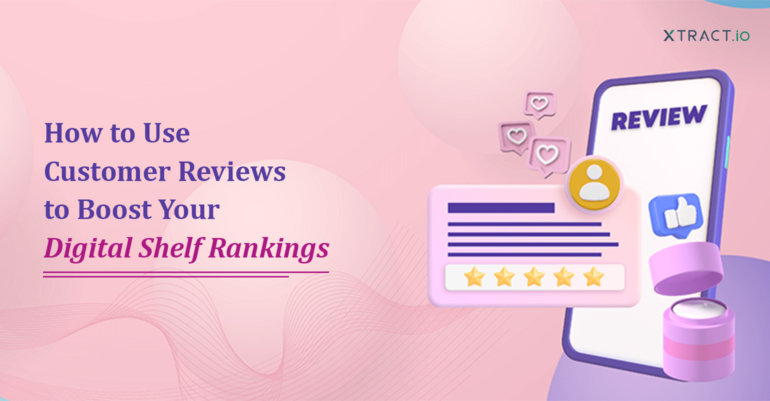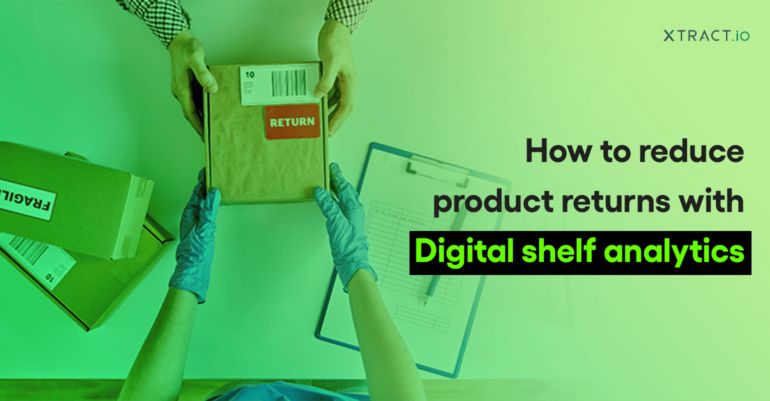Keeping a close eye on your competitor can be a game-changer in the ever-evolving business landscape. By implementing a competitive pricing strategy, you can identify who your competition is and their product offerings. By gaining insights into your competitors and their pricing strategy, you can competitively price your goods, utilize the marketing mix to its fullest potential, and increase your product visibility across marketplaces.
This is a two-way street. Similarly, your competitors learn about your brand as well. There is a high chance your competition might be observing your pricing strategies, product offerings, and marketing tactics. This blog post will delve into the significance of competitive pricing and the four key things your business may miss out on while developing a strategy.
What is a competitive pricing strategy?
It’s no secret that your competitors can access the prices you charge for your products. They are legally spying on you, plain and simple. A solid competitive pricing strategy can enable your brand to remain competitive and grow sales across marketplaces.
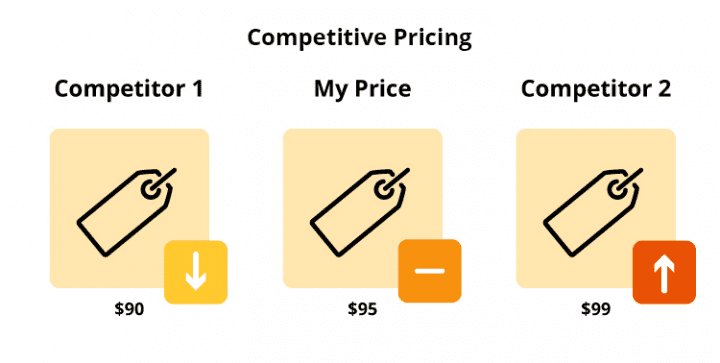
Competitive pricing is a strategic approach businesses use to set their prices, allowing them to compete effectively with other players in the market. It involves analyzing market dynamics, understanding customer behavior, and pricing products at a point that attracts customers while still generating profits.
For example, let’s assume you are a smartphone-selling brand. And several leading smartphone brands are competing for market share. Every brand strives to position its products as the most appealing option to potential customers. And these brands set their pricing strategy based on the value proposition and market analysis.
Brand X determines that its target customers are willing to pay a premium for quality cameras. In response, Brand X sets a slightly higher price than its competitors, reflecting the added value of its camera technology. On the other hand, Brand Y offers a competitive price for long battery life with additional accessories. So now, Brand X may emphasize its cutting-edge camera technology, while Brand Y may highlight its long battery life and durability. If Brand Z introduces a new smartphone with similar features at a lower price. In that case, Brand X and Y may have to reassess their pricing strategies and make necessary adjustments to remain competitive.
This makes it clear that developing a competitive pricing strategy is a dynamic process that involves understanding customer preferences, highlighting unique value propositions, and strategically setting prices to attract target customers while considering the prices offered by competitors.
The pros of competitive pricing
Implementing a competitive pricing strategy offers several benefits for ecommerce brands.

Preventing market loss
A customer’s purchasing decision is influenced heavily by price. Competitive pricing can reduce the risk of losing customers to competitors. While those prices don’t always have to be the lowest, they should be within the acceptable range for your target market. Understanding the market dynamics and setting prices accordingly helps you retain and attract new customers.
Increasing profits
Competitive pricing strategies can potentially increase profits regardless of whether you price your products lower, higher, or equal to the competition. Pricing lower than the competition can attract a larger customer base and drive higher sales volume. On the other hand, pricing higher than the competition allows you to capture a premium market segment and maximize profit margins per sale. Pricing equal to the competition, with effective marketing and product differentiation, can help you maintain profitability.

Simplicity and low risk
Basing your prices on a limited number of competitors can help you easily adjust your prices to stay competitive. This low-risk approach ensures that your prices align with market expectations and reduces the chance of losing customers due to pricing discrepancies.
The cons of competitive pricing
While competitive pricing strategies have advantages, there are also some considerations and potential drawbacks to consider.
Complexity
Continuously monitoring your competitors’ prices and adjusting your prices as necessary will help you remain competitive. This tracking process and market research can be complex and time-consuming. Utilizing a digital shelf analytics platform can streamline the process and ensure you stay up-to-date with the real-time market dynamics.
Risk of devaluing products
Pricing products too low, especially when aiming to undercut the competition, can devalue your brand and products in customers’ eyes. While lower prices can attract budget-conscious shoppers, it’s important to maintain the perception of the quality and value of the brand. Communicate your products’ unique selling points and advantages to justify their price and differentiate them from cheaper alternatives.
Pricing alone is not enough
Competitive pricing is just one part of a successful ecommerce strategy. Complementing your pricing with effective promotions, stock availability, customer experience, and product visibility is essential. Highlighting your products’ descriptions with unique features and having high-quality product images will help you stand out.
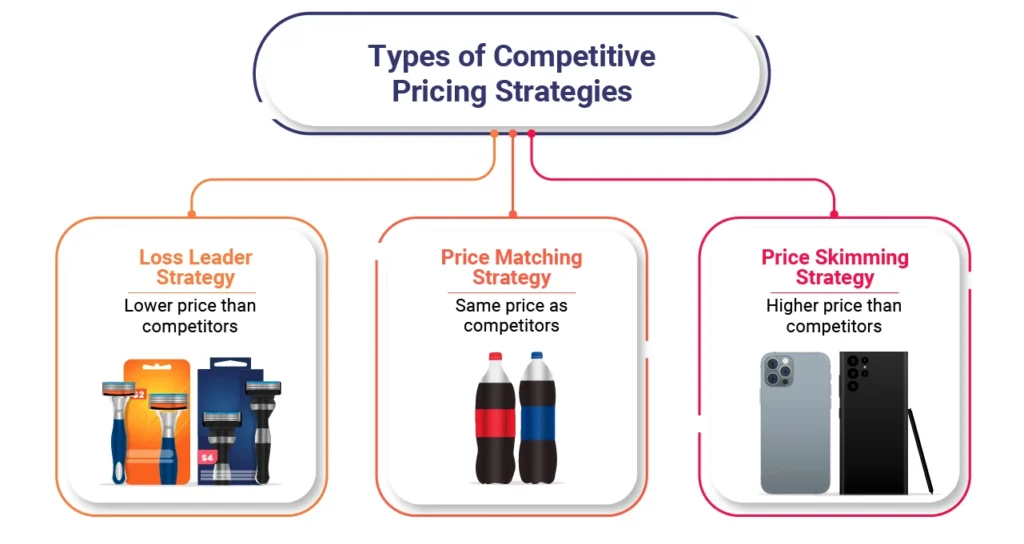
4 Key things that brands are likely to miss out
When it comes to competitive pricing analysis, there are four key things that brands often miss out on.
1. Dynamic pricing: Brands often underestimate the potential of dynamic pricing. It is a feasible pricing strategy that allows brands to adjust real-time prices to cope with market conditions and win more sales. By leveraging digital shelf intelligence, you can gather valuable data to implement dynamic pricing strategies, optimizing prices for maximum profitability and competitiveness.
2. Competitive benchmarking: It is vital to benchmark your prices against competitors actively. Your brand can gain insights into competition-based pricing strategies, allowing them to identify pricing gaps and opportunities to increase sales using competitive intelligence.
3. Consumer sentiment and perception: While robust analytics provide valuable insights into pricing trends and competitor strategies, analyzing consumer sentiment and product ratings is another overlooked aspect. Understanding how customers perceive pricing is crucial for effective pricing strategies. It would be best to analyze consumer feedback, reviews, and sentiment analysis to align pricing with customer expectations and preferences.
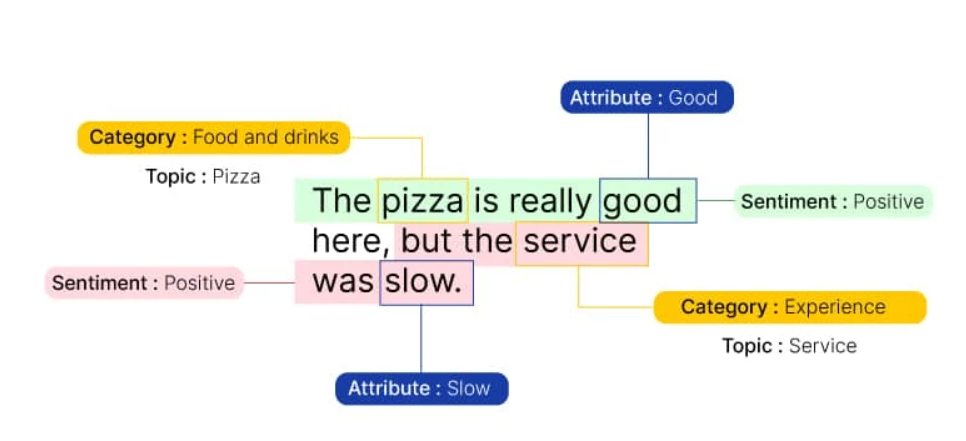
4. Monitoring and optimization: Developing a competitive pricing strategy is a continuous endeavor that demands consistent monitoring and optimization efforts. Constantly monitoring and analyzing pricing data without efficient analytics becomes more time-consuming and challenging. Digital shelf analytics can help you accelerate round-the-clock monitoring and track performance metrics that will eventually increase conversions.
Use DigiSense360 to stay competitive
While many businesses still rely on manual searches to gather information about rival products and prices, this approach is time-consuming and inefficient. Fortunately, a fully automated competitor price tracking dashboard is available on DigiSense360. It is a digital shelf intelligence platform enabling real-time competitor monitoring for brands and retailers.
DigiSense360 offers a proactive approach to competitor price monitoring and benchmarking. The platform ensures you are constantly up to date by tracking the key metrics, which makes the necessary data easily accessible to make vital pricing decisions.
DigiSense360 allows you to monitor and analyze historical and real-time pricing data to ensure optimal prices. Additionally, you can collect accurate data on top-performing products and product assortments to identify gaps and find new revenue opportunities.
With our competitive intelligence, you can clearly understand your product’s performance against your competition to offer competitive prices that can effectively boost sales and conversions without investing excessive time, money, and workforce.
DigiSense360’s digital shelf intelligence also offers supporting capabilities to enhance product content and compliance, optimize the share of search performance, and ensure brand protection. You can leverage it to monitor product reviews and ratings, conduct sentiment analysis, and get insights into your brand’s perception and product experience.
Get in touch with us to discover how you can leverage a competitive pricing strategy to ensure success in the digital marketplace.



